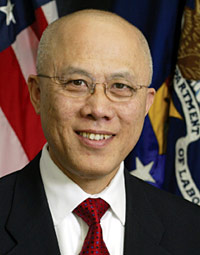|
DOL Annual Report, Fiscal Year 2003
Chief Financial Officer's Letter
 |
Samuel T. Mok
Chief Financial Officer |
In the past, Federal financial management has been much like the helpful bystander in the story of the lost hot air balloonist. Descending from a cloud bank, the balloonist sees a bystander on the ground and asks, "I am lost; can you tell me where I am?" The bystander replies, "You're in a hot air balloon approximately 100 feet off the ground." The balloonist shouts back, "You must be a government accountant." The astonished bystander says, "Why yes, how did you know?" The balloonist replies, "Everything you told me is technically correct, but it's of no use to me." We can also say that the bystander is like the proverbial frog at the bottom of a well—capable of providing in-depth information, but of such narrow scope that it becomes irrelevant. Information must be useful as well as accurate and timely to make a difference. That is our goal at the Department of Labor (DOL).
The Chief Financial Officers Act of 1990 envisions a broad oversight role for financial management in government activities and programs. Despite these statutory provisions, the financial management community often finds itself like the unarmed "London bobby" whose most potent weapon is their presence and the respect they are given. But even unarmed, accountants and financial managers can and do make a difference. Remember, it was the accountants who put Al Capone in jail. Effective accounting does make a difference.
DOL has a firmly established reputation for the integrity and reliability of our financial information. The receipt of the Association of Government Accountant's Certificate of Excellence in Accountability Reporting and a seventh consecutive unqualified opinion on our consolidated financial statements confirms these qualities. The Department maintained its "yellow" status score and "green" progress score in financial management. Before us lies the challenge to provide timely, accurate, and useful information to enable program managers and policy officials to better manage the resources entrusted to our stewardship. We must provide the American people with the best results we can achieve.
We, in the financial management community, must move beyond work processes rooted in 20th century practices which are heavily weighted toward transaction processing and provide limited decision support. We must learn to take advantage of advances such as single-point data entry and web-based technologies. These tools will allow us to redeploy our limited resources to broader and deeper decision support activities. We must continue to expand and enhance our managerial cost accounting capabilities so that integrated financial and performance information becomes a routine tool for making critical day-to-day and long-term decisions. Such integration makes information useful. It will lead to more informed operational decisions and secure the best performance from the Department's many important programs.
The President has placed a high priority on ensuring that Federal government resources are well managed and wisely used. In support of the President's Management Agenda (PMA), in FY 2004 we will begin work to identify and reduce erroneous payments through an aggressive program that proactively improves internal controls and eliminates any systemic causes of improper payments. Already, we have begun to develop methodologies to identify the occurrence and to correct the causes of erroneous payments in the Department's Unemployment Insurance Program.
Financial management systems are a critical component of any effort to reduce erroneous payments and improve fiscal responsibility in general. DOL's financial management systems comply with the Federal Financial Management Improvement Act (FFMIA), and for the third consecutive year the Secretary has reported that our systems of accounting and internal controls comply with the Federal Managers' Financial Integrity Act (FMFIA). We are moving beyond rote compliance with these statutes in efforts to demonstrate the Department's commitment to effective stewardship of public funds. In the spirit of the Sarbanes-Oxley Act of 2002, we put in place a quarterly process for agency heads as well as an expanded list of key financial and program managers to attest to the existence and effectiveness of internal controls throughout their organization. This monitoring provides us a critical tool to proactively identify and correct developing deficiencies before they pose a greater challenge.
Finally, this past year, DOL's Office of the Chief Financial Officer co-led the government-wide financial management line of business initiative which focuses on developing a government-wide core financial system architecture, including standard data structures and business processes. Internally, we will replace our own core accounting system to take advantage of state-of-the-art technology and best-practice business processes. This will lead the Department's financial management practices from transaction processing to value-added financial analysis and real-time decision support in the near future.
The changes we seek can be seen as two pyramids. The old pyramid has a thick foundation of resources dedicated to transaction processing, a slightly less thick, but still sizeable, layer of reporting activities, and a small capstone of decision-support. In the new pyramid, technology and smarter business practices greatly lessen the need to expend resources on transaction processing and reporting. These freed resources will move upward in the pyramid to form a large decision support layer capped by significant new decision rendering capabilities.
President Bush and Secretary Chao are Harvard MBAs with a deep appreciation for effective financial management and sound fiscal integrity. Under their leadership, we will continue to make DOL a 21st Century organization where timely, accurate, and useful financial and performance information improve decisions and deliver results. This is a legacy that will benefit the Department and American taxpayers for years to come.
Samuel T. Mok Chief Financial Officer
|



